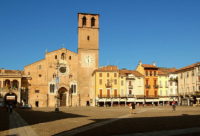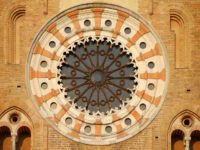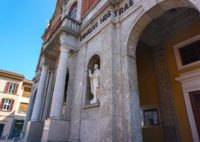Important agricultural and industrial centre, with historical connections, on the right bank of the river Adda. The Duomo was begun in 1160, and has a facade which has obviously been altered many times. The large, solemn interior contains important paintings including a polyptych by Callisto Piazza (c. 1500-1562) depicting the Massacre of the Innocents; and a polyptych of the Assunta by Martino Piazza (recorded 1514-1527); in the chancel are eleven works in marquetry by fra’ Giovanni da Verona (c. 1457-1525). 18th cent. Broletto, with Baroque facade.
The Renaissance-style Santuario dell’Incoronata (begun in 1488) contains important works of art, including four panels by Ambrogio da Fossano, called Bergognone (c. 1455-1522). The church of San Cristoforo was completely rebuilt to a design by Pellegrino Tibaldi called Pellegrino Pellegrini (1527-1596).
The former monastery of St. Philip houses the Museo Civico, with a section containing 17-19th cent, ceramics, and an important art gallery, with works by Callisto Piazza, Cesare da Sesto (1477-1523), and other good artists. The church of San Francesco, built at the end of the 13th cent., in Gothic-Lombard style, contains extremely interesting 14th and 15th cent. frescoes by local and other Lombard painters.
The Ospedale Maggiore (15-16th cent.) has an interesting courtyard (1473). The 14th cent. church of Sant’ Agnese is in Gothic-Lom-bard style; inside is a polyptych by Albertino Piazza (c. 1475-1529). The church of San Lo-renzo (12-13th cent.) contains a fresco of the Re-surrection by Callisto Piazza, and a Pieta by Bernardino Campi (1552-1591). In the church of San Bassiano, which has a Gothic facade, is a valuable series of 14th cent. frescoes.


























